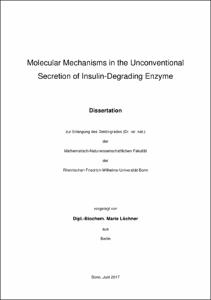Löchner, Marie: Molecular Mechanisms in the Unconventional Secretion of Insulin-Degrading Enzyme. - Bonn, 2018. - Dissertation, Rheinische Friedrich-Wilhelms-Universität Bonn.
Online-Ausgabe in bonndoc: https://nbn-resolving.org/urn:nbn:de:hbz:5n-50151
Online-Ausgabe in bonndoc: https://nbn-resolving.org/urn:nbn:de:hbz:5n-50151
@phdthesis{handle:20.500.11811/7526,
urn: https://nbn-resolving.org/urn:nbn:de:hbz:5n-50151,
author = {{Marie Löchner}},
title = {Molecular Mechanisms in the Unconventional Secretion of Insulin-Degrading Enzyme},
school = {Rheinische Friedrich-Wilhelms-Universität Bonn},
year = 2018,
month = apr,
note = {Extracellular deposition of amyloid-ß (Aß) plaques in the brain, a hallmark of Alzheimer’s disease (AD), results from an imbalance between production and clearance of the peptide. Insulin-degrading enzyme (IDE) is one of the major proteases that degrade monomeric Aß in the brain and is suggested to be mainly involved in the removal of extracellular Aß. Recent studies demonstrated that the enzyme is released by microglial cells via the unconventional exosome secretory pathway, but little is known about the regulation of IDE secretion and sorting into extracellular vesicles.
This work revealed that serotonin (5-HT) stimulates the secretion of exosome associated IDE from microglial cells. Activation of the 5-HT receptors 2a, 2b and 4 induces an elevation of intracellular Ca 2+ which is likely to promote the release of IDE. Co-culture experiments showed that the presence of neurons stimulates secretion from and expression of IDE in microglial cells.
Further experiments revealed that inhibition of nSMase2 that decreases ceramide production unexpectedly increased IDE release from microglial cells, whereas the secretion of other exosomal proteins rather decreased or remained unaffected. RNAi-mediated knockdown of the ESCRT-associated ATPase Vps4B elevated secretion of IDE without affecting the trafficking of IDE to MVBs or its secretion via exosomes. Vps4B depletion promoted IDE release by increasing microvesicle shedding. Interestingly, Vps4B was identified as potential interaction partner of IDE in a yeast two-hybrid screen and confirmed by co-immunoprecipitation. Depletion of IDE or Vps4B, respectively, did not influence the usual complex formation of both proteins. But because knockdown of Vps4B in BV-2 microglial cells also increased IDE-mediated degradation of extracellular Aß and insulin, it could be assumed that the interaction of IDE and Vps4B might modulate IDE protease activity.
Moreover, transient knockdown of IDE increased the release of Alix from microglial cells by enhancing its subcellular transport to MVBs suggesting a role for IDE itself in the regulation of exosome secretion. Secretion analyses in primary rat astrocytes and fibroblast cos-7 cells revealed cell type- and cargo-dependent differences in the ceramide-, Vps4B- and IDE-mediated regulation of exosome release. This suggests not only the existence of distinct exosome subpopulations but also distinct mechanisms of exosome biogenesis dependent on cell type and the particular cargo protein.
Together these results indicate a complex interaction of several regulatory mechanisms for IDE secretion in microglial cells and suggest the potential involvement of further pathways for IDE export regulated by Vps4B and nSMase2.},
url = {https://hdl.handle.net/20.500.11811/7526}
}
urn: https://nbn-resolving.org/urn:nbn:de:hbz:5n-50151,
author = {{Marie Löchner}},
title = {Molecular Mechanisms in the Unconventional Secretion of Insulin-Degrading Enzyme},
school = {Rheinische Friedrich-Wilhelms-Universität Bonn},
year = 2018,
month = apr,
note = {Extracellular deposition of amyloid-ß (Aß) plaques in the brain, a hallmark of Alzheimer’s disease (AD), results from an imbalance between production and clearance of the peptide. Insulin-degrading enzyme (IDE) is one of the major proteases that degrade monomeric Aß in the brain and is suggested to be mainly involved in the removal of extracellular Aß. Recent studies demonstrated that the enzyme is released by microglial cells via the unconventional exosome secretory pathway, but little is known about the regulation of IDE secretion and sorting into extracellular vesicles.
This work revealed that serotonin (5-HT) stimulates the secretion of exosome associated IDE from microglial cells. Activation of the 5-HT receptors 2a, 2b and 4 induces an elevation of intracellular Ca 2+ which is likely to promote the release of IDE. Co-culture experiments showed that the presence of neurons stimulates secretion from and expression of IDE in microglial cells.
Further experiments revealed that inhibition of nSMase2 that decreases ceramide production unexpectedly increased IDE release from microglial cells, whereas the secretion of other exosomal proteins rather decreased or remained unaffected. RNAi-mediated knockdown of the ESCRT-associated ATPase Vps4B elevated secretion of IDE without affecting the trafficking of IDE to MVBs or its secretion via exosomes. Vps4B depletion promoted IDE release by increasing microvesicle shedding. Interestingly, Vps4B was identified as potential interaction partner of IDE in a yeast two-hybrid screen and confirmed by co-immunoprecipitation. Depletion of IDE or Vps4B, respectively, did not influence the usual complex formation of both proteins. But because knockdown of Vps4B in BV-2 microglial cells also increased IDE-mediated degradation of extracellular Aß and insulin, it could be assumed that the interaction of IDE and Vps4B might modulate IDE protease activity.
Moreover, transient knockdown of IDE increased the release of Alix from microglial cells by enhancing its subcellular transport to MVBs suggesting a role for IDE itself in the regulation of exosome secretion. Secretion analyses in primary rat astrocytes and fibroblast cos-7 cells revealed cell type- and cargo-dependent differences in the ceramide-, Vps4B- and IDE-mediated regulation of exosome release. This suggests not only the existence of distinct exosome subpopulations but also distinct mechanisms of exosome biogenesis dependent on cell type and the particular cargo protein.
Together these results indicate a complex interaction of several regulatory mechanisms for IDE secretion in microglial cells and suggest the potential involvement of further pathways for IDE export regulated by Vps4B and nSMase2.},
url = {https://hdl.handle.net/20.500.11811/7526}
}






